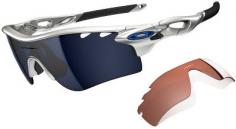The original Oakley Radar was a sports optics game-changer when it landed in the pro peloton in 2007. It was exceptionally lightweight, offered an excellent fit under a wide variety of cycling helmets, and the carefully sculpted design was simultaneously aggressive and universally wearable. The Radar did a lot of things right, but taking advantage of the frame's lens interchangeability was, more often than not, tedious at best, and required a flowchart at worst. It was almost easier to simply own multiple pairs for different applications than to try changing the lenses. To put an end to this frustration, Oakley introduced the Radarlock Path - a subtly redesigned Radar, quite possibly the quintessential sporting sunglass. Lay the two next to each other, and you'll notice that the geometry, frame profiles, and signature earstem exhaust ports of the original Radar and the new Radarlock are more or less the same. But that's about where the similarities end. The Radarlock is constructed from the same lightweight O-Matter polycarbonate, but the earstems are now constructed from several different pieces, giving them a more dramatically sculpted design that grants a slightly greater degree of outward flex. The O-Matter hinges are now tensioned, giving them a slight spring when opening or closing. Oakley also opted to terminate the Unobtanium rubber earsocks a bit further from the stem tips to give the glasses a better fit with many helmet retention systems, and also to leave room for perforations that allow fitment of a retention strap (sold separately). As evidenced by its name, the Radarlock is characterized by Oakley's Switchlock technology, which allows you to change out the lens quickly and efficiently. Due to the Radar's unique Polaric Ellipsoid shield lens geometry, the mechanism is a little different than what you'd find on the Jawbone or Fast Jacket, but very simple nonetheless. Simply engage the slider switch on the inside of the left temple, and pivot the ear.


